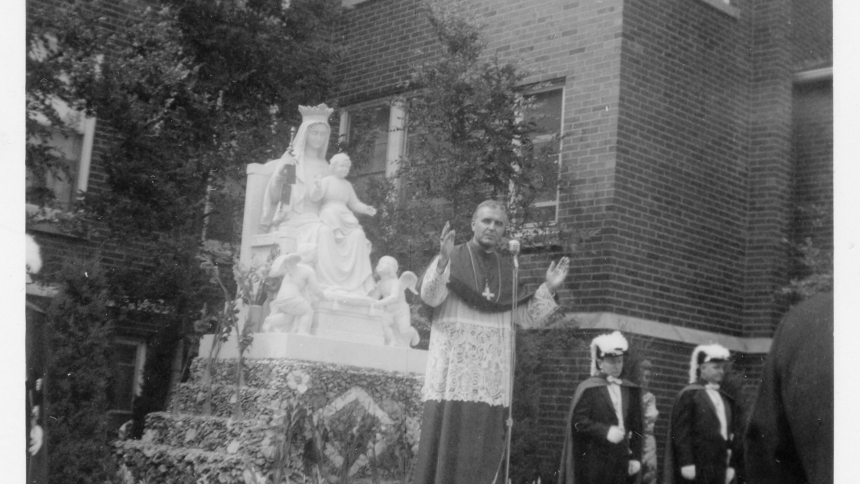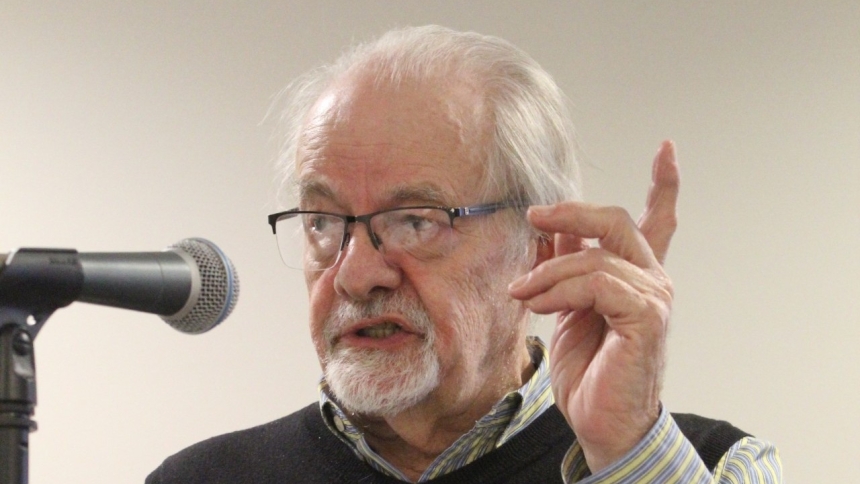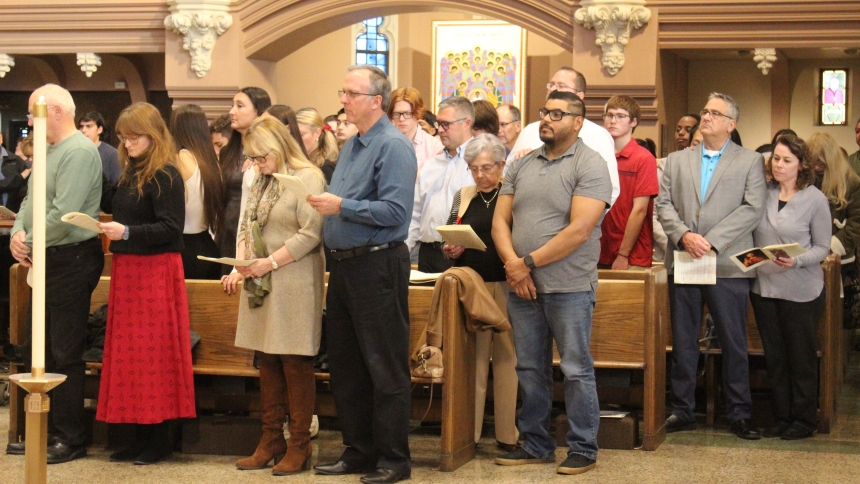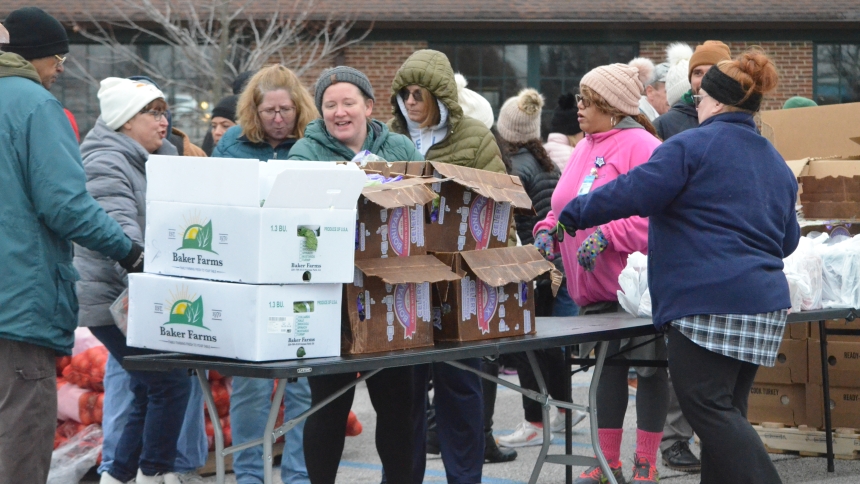
MUNSTER – World War II changed the lives of millions of people around the world, including a small group of Polish Discalced Carmelites, chaplains of the Polish Army, who came to the United States after serving out the war in the United Kingdom.
They fulfilled St. Raphael Kalinowski’s dream of a Polish Carmel in America when they established a monastery in Hammond in 1950 at the invitation of the Diocese of Fort Wayne, said the current prior (superior), Father Andrzej Gbur, O.C.D. Two years later they moved to Munster after purchasing a convent, and immediately began their pastoral ministry among the Polish-American community in the Chicagoland area.
“The Discalced Carmelites immigrated to the U.S. along with Polish refugees after the war and decided to come to Hammond, with permission from the diocese to have a monastery and help in local parishes,” explained Father Gbur, who first served at the Munster monastery from 2003-06 and, after returning to Poland to direct the order’s publishing house and study for a year in Spain, came back to Munster in 2015.
This Saturday, July 19, the current group of seven priests and one religious brother will welcome worshippers to their home for a 75th anniversary Mass celebrated by Bishop Robert J. McClory at 5 p.m. Following Mass, the festivities will move outdoors, weather permitting, for fellowship, choral music and a variety of food available for purchase. At 8 p.m., the Carmelites will host Eucharistic adoration, also outdoors, and a praise and worship service.
“It will be a day to honor Our Lady of Mount Carmel and a chance for all of those who made this place what it has become to gather as one community and pray together,” said Father Gbur. “Those who wish can also have the opportunity to receive the Holy Scapular.
“In 75 years, this monastery has changed a lot,” added Father Gbur. An elderly neighbor recalls five Sunday Masses in Polish, he said, and as recently as 2004, “we had 15 brother priests here and were helping serve 25 parishes.”
As Polish parishes closed, he noted, “We now mostly have English, some Polish and also Spanish Masses. Daily Masses at the monastery are celebrated at 6 and 8 a.m. Monday through Saturday, with vespers nightly at 6 p.m. and another Mass in Polish at 7 p.m. Monday-Thursday and in English on Friday. “On Thursdays we offer confessions and Eucharistic adoration beginning after the 8 a.m. Mass up until the 7 p.m. Mass,” added Father Gbur.
Sunday liturgies are held at 8:30 a.m. and noon in Polish, with an English Mass at 10:30 a.m.
The newest addition to the monastery is the Carmelitana Café, a cozy coffee shop, with a patio, created out of a storage room behind the main church. Open Sundays between Masses, from 9 a.m. to 2 p.m., the café offers coffee, tea and sweets in a contemporary setting featuring stunning artwork by local chiarscouro painter Lidia Wylangowska, who along with her husband, Christopher, helped establish the café.
Historic photos on the walls highlight Carmelite Monastery priests and supporters throughout the years, as well as guests that have included St. Mother Teresa of Calcutta and Franciszek Gajowniczek, the man St. Maximilian Kolbe sacrificed his life for at Auschwitz.
In addition to building a monastery and shrine dedicated to the Virgin Mary under the title of Our Lady of Mount Carmel, the Carmelites constructed a grotto in her honor in the monastery garden under the title of Our Lady of Lourdes. On the upper level, around the altar in the Chapel of Our Lady of Częstochowa, they placed urns with the ashes of WWII prisoners who were murdered in Nazi concentration camps and Soviet labor camps.
In subsequent years, a monument to the Sacred Heart of Jesus was erected, while the garden was adorned with a Polish Highlanders’ chapel dedicated to Christ as the Man of Sorrows and his Mother Mary under the title of Our Lady of Ludźmierz, a monument of St. Therese of the Child Jesus, as well as a monument of St. Maximilian Kolbe, the martyr of Auschwitz.
In the monastery building, following the election of Karol Wojtyła as the first Polish pope, the fathers built the Pope John Paul II hall containing a photo exhibit of his life and apostolic pilgrimages as well as a life-size bronze sculpture of the Holy Father.
Alongside the monastery church, the fathers built a chapel dedicated to Mary under the title of Our Lady of Ostra Brama, and later added the St. Raphael Kalinowski Pilgrim Center and Banquet Hall near the entrance to the shrine.
In 2004, Pope John Paul II bestowed on the Carmelite Monastery the distinction of receiving his “Golden Rosary,” issuing a special Papal Bull which reads: “To Our Lady of Ludźmierz, Queen of the Polish Highlanders, honored at the Carmelite Shrine in Munster, in the Chicago area, as patroness of the Polish Highlanders’ Union in North America, I bequeath as a votive offering the Golden Rosary, a filial chain which, through Mary, binds us to Jesus … I cordially impart my Apostolic Blessing.”
The Carmelite Fathers in Munster provide religious instruction for St. Raphael Kalinowski Polish Saturday school housed at the monastery, host the Millennium Choir, and serve as chaplains for the Pope John Paul II Senior Citizen Society and the Secular Carmelite Order. The school is independent, but still very important to us,” Father Gbur noted.
“People asked us for Spanish Masses, and we want to serve the needs of the people, so Bishop McClory approved it, and we do have Spanish Masses now,” he said. Father Bruno Socha, O.C.D., the best Spanish speaker among the Carmelites, is the celebrant at a 7 p.m. Spanish Mass offered on first Saturdays of the month, and serves as chaplain for the Hispanic group, Lazos de Amor Mariano, that meets every Wednesday at the Shrine.
“Besides this group, we also have the Secular Carmelite Order (English-speaking group), the “Living Rosary” group (Polish), and the Knights of the Immaculata of St. Maximilian Kolbe, an English-speaking group that meets for First Saturday devotions,” said Father Gbur.
The three-story Grotto on the grounds, displaying many statues and shrines, is open free to the public from 9 a.m. to 5 p.m. on Sundays, from Easter through October,
In addition, to meet the needs of Polish-Americans in the Chicago area, the Discalced Carmelites of Munster served for many years in various Chicago parishes, and now celebrate two Sunday Masses at St. Thomas More in Munster and help at St. John the Evangelist in St. John. “We have very beautiful cooperation with our Munster community and the entire diocese,” noted Father Gbur.
Another initiative of the Polish Carmelites in Munster was a settlement opened in the late 1980’s in Korona, Fla., where they established a shrine dedicated to St. Joseph.
“We are trying to help the Diocese of Gary community, and now we pray for new brothers to join us,” said Father Gbur. “I am just so happy to be surrounded by these people.”
Caption: Bishop Andrew Grutka, first bishop of the Diocese of Gary, blesses the statue of Our Lady of Mount Carmel in front of original Carmelite Monastery building in Munster in 1959, just two years after the diocese was established and nine years after the Discalced Carmelite Fathers arrived in Northwest Indiana. (Provided photo)



